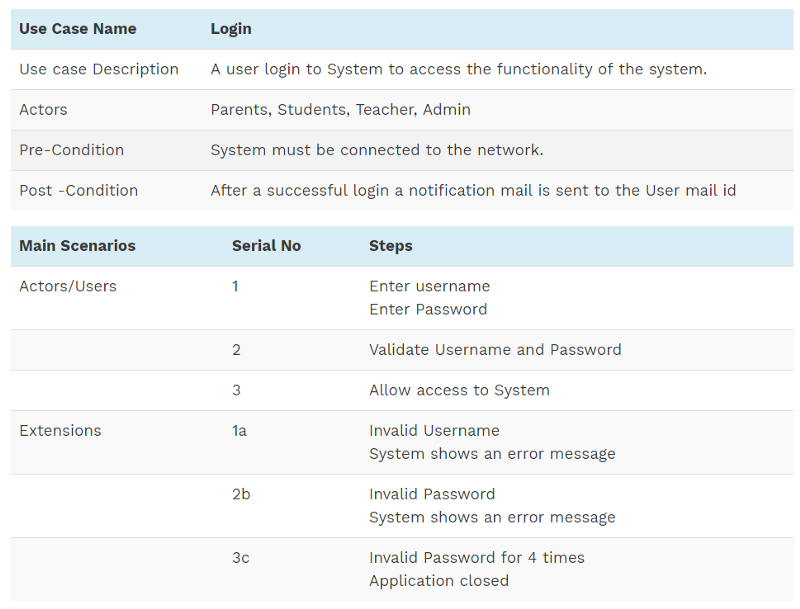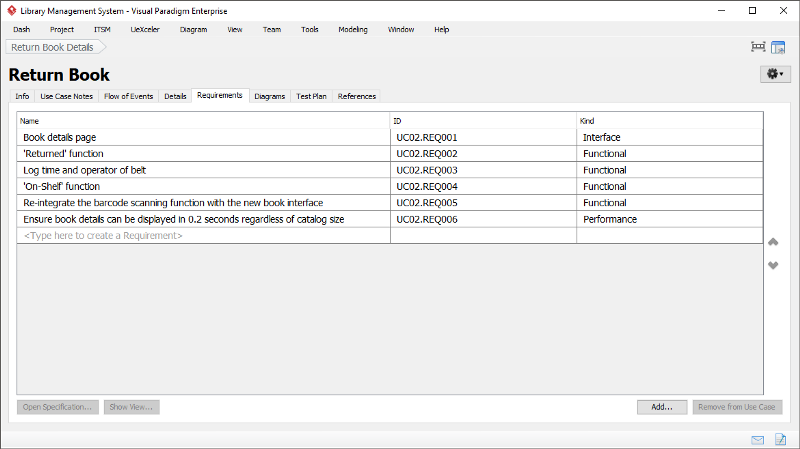Przypadek użycia to pisemny opis tego, jak użytkownik wykonuje zadanie w twoim systemie. Opisuje zachowanie systemu z perspektywy użytkownika w odpowiedzi na żądanie. Każdy przypadek użycia jest przedstawiony jako sekwencja prostych kroków, zaczynając od celu użytkownika i kończąc, gdy cel zostanie osiągnięty.
Przypadek użycia Przykład: System zarządzania szkołą
Tutaj wyjaśnię przypadek 'Logowanie’:

Szukasz narzędzia do przypadków użycia do dokumentowania diagramu przypadków użycia oraz szczegółowego opisu przypadków użycia? (Więcej szczegółów)
Opis przypadku użycia
Podejście skoncentrowane na przypadkach użycia do zbierania wymagań.

Edytor przepływu zdarzeń
Wymień kroki związane z realizacją przypadku użycia za pomocą narzędzia przepływu zdarzeń. Przepływ zdarzeń jest kluczowym elementem każdego opisu przypadku użycia. Oprogramowanie do przypadków użycia zawiera potężne narzędzie do zdarzeń, które wspiera edytowanie makiet, dokumentowanie rozszerzonego przepływu, odniesienia do włączonego przypadku użycia oraz prezentowanie logiki biznesowej z użyciem operatorów if-then oraz pętli. Co więcej, możesz generować diagram sekwencji na poziomie systemu oraz diagram aktywności z przepływu zdarzeń do wykorzystania w komunikacji pomysłów projektowych systemu.

Edytor notatek opartych na przypadkach użycia
Jako wszechstronne narzędzie do analizy przypadków użycia, edytor opisu przypadków użycia wspiera dodatkowe funkcje notowania oprócz tradycyjnego szablonu przypadku użycia. Dyskutuj wymagania z interesariuszami i zapisuj ich prośby, sugestie i obawy w edytorze notatek przypadków użycia. Edytor notatek zapewnia podejście skoncentrowane na przypadkach użycia do zarządzania potrzebami użytkowników zebranymi w dyskusjach i burzach mózgów. Możesz organizować elementy notatek w hierarchii, podkreślać kluczowe treści za pomocą funkcji formatowania, takich jak pogrubienie i kursywa, a nawet generować przepływy zdarzeń selektywnie z elementów notatek.

Wymagania w przypadku użycia
Przypadek użycia reprezentuje cel biznesowy. Zarządzanie wymaganiami w ramach przypadków użycia zachęca do tworzenia, wdrażania i zarządzania wymaganiami, które szanują i są zgodne z ustalonymi celami biznesowymi. To podejście do zarządzania wymaganiami zapobiega marnotrawstwu siły roboczej, czasu rozwoju i kosztów wynikających z rozwijania niechcianych funkcji.

Rozwijanie przypadków użycia za pomocą poddiagramów
Użyj diagramu sekwencji do modelowania interakcji systemu, diagramu aktywności do modelowania wysokopoziomowego przepływu programowania, diagramu procesów biznesowych BPMN do modelowania działalności biznesowej oraz diagramu wymagań SysML do modelowania funkcji systemu. Weź przypadek użycia jako punkt wyjścia do projektowania systemu, rozwijaj go za pomocą innych diagramów i zarządzaj nimi wszystkimi w ramach przypadku użycia, schludnie i z możliwością śledzenia.

Zarządzanie artefaktami referencyjnymi
Zarządzaj plikami uzupełniającymi, stronami internetowymi, wewnętrznymi modelami i powiązaniami diagramów jako odniesieniami do przypadku użycia. Te odniesienia dostarczają szczegółów dotyczących przypadku użycia, co ułatwia komunikację i bieżący rozwój przypadku użycia. Narzędzie do przypadków użycia pomaga utrzymać wszystkie odniesienia w zorganizowany sposób.

Generowanie pełnej specyfikacji przypadku użycia
Natychmiast wygeneruj pełną specyfikację przypadku użycia, która składa się z szczegółów zebranych w ramach przypadku użycia. Nasz potężny silnik raportujący pomaga zebrać i zorganizować wszystkie szczegóły przypadku użycia oraz przedstawić je w sposób zrozumiały zarówno dla zespołów deweloperskich, jak i interesariuszy.

Artykuły o zjednoczonym języku modelowania
- Czym jest UML?
- Dlaczego modelowanie UML?
- Przegląd 14 typów diagramów UML
- Czym jest diagram klas?
- Czym jest diagram komponentów?
- Czym jest diagram wdrożenia?
- Czym jest diagram obiektów?
- Czym jest diagram pakietów?
- Czym jest diagram struktury złożonej?
- Czym jest diagram profilu?
- Czym jest diagram przypadków użycia?
- Czym jest diagram aktywności?
- Czym jest diagram maszyny stanowej?
- Czym jest diagram sekwencji?
- Czym jest diagram komunikacji?
- Czym jest diagram przeglądu interakcji?
- Czym jest diagram czasowy
Ten post dostępny jest również w Deutsch, English, Español, فارسی, Français, Bahasa Indonesia, 日本語, Portuguese, Ру́сский, Việt Nam, 简体中文 and 繁體中文













